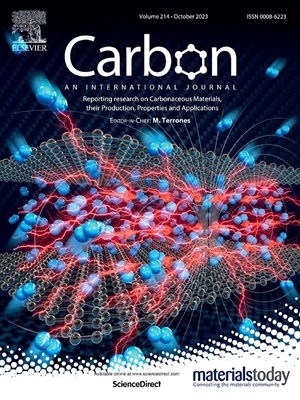机器学习驱动的纳米多孔非晶碳机械变形的原子模拟
IF 10.5
2区 材料科学
Q1 CHEMISTRY, PHYSICAL
引用次数: 0
摘要
纳米多孔非晶碳(NP α-C)是下一代储能系统中很有前途的材料,特别是作为锂离子电池阳极的关键部件。然而,其无序的原子结构和复杂的纳米孔隙度为理解其结构-性能关系带来了重大挑战。在这项研究中,我们使用高斯随机场方法结合机器学习驱动的分子动力学模拟,生成并分析了超过20万个唯一的NP α-C构型。这种方法可以创建一个广泛的结构数据库,涵盖孔隙度从10%到90%,平均孔径从5到60 Å,孔径差异从0到60 Å2。我们的研究结果表明,孔隙结构在NP α-C的弹塑性行为中起着至关重要的作用。在三轴拉伸下,应力集中在韧带连接处,导致韧带变薄,单链形成,最终断裂。循环加载试验进一步表明,大多数断裂发生在第一个循环中,在随后的循环中,裂纹扩展最小,弹性常数显著降低。该研究为优化NP α-C微结构建立了一个强大的理论框架,为设计用于储能应用的高性能多孔材料提供了有价值的见解。本文章由计算机程序翻译,如有差异,请以英文原文为准。

Machine learning-driven atomistic simulation of mechanical deformation in nanoporous amorphous carbon
Nanoporous amorphous carbon (NP α-C) is a promising material for next-generation energy storage systems, particularly as a key component in lithium-ion battery anodes. However, its disordered atomic structure and complex nanoscale porosity pose significant challenges for understanding its structure-property relationships. In this study, we generated and analyzed over 200,000 unique NP α-C configurations using the Gaussian Random Field Method combined with machine learning-driven molecular dynamics simulations. This approach enabled the creation of an extensive structural database, covering porosities from 10 % to 90 %, average pore sizes from 5 to 60 Å, and pore size variances from 0 to 60 Å2. Our findings reveal that pore structure plays a crucial role in governing the elastic and plastic behavior of NP α-C. Under triaxial tension, stress concentrates at ligament-junction regions, leading to ligament thinning, single-chain formation, and eventual fracture. Cyclic loading tests further demonstrate that most fractures occur in the first cycle, with minimal crack propagation and a significant reduction in elastic constants in subsequent cycles. This study establishes a robust theoretical framework for optimizing NP α-C microstructures, offering valuable insights into the design of high-performance porous materials for energy storage applications.
求助全文
通过发布文献求助,成功后即可免费获取论文全文。
去求助
来源期刊

Carbon
工程技术-材料科学:综合
CiteScore
20.80
自引率
7.30%
发文量
0
审稿时长
23 days
期刊介绍:
The journal Carbon is an international multidisciplinary forum for communicating scientific advances in the field of carbon materials. It reports new findings related to the formation, structure, properties, behaviors, and technological applications of carbons. Carbons are a broad class of ordered or disordered solid phases composed primarily of elemental carbon, including but not limited to carbon black, carbon fibers and filaments, carbon nanotubes, diamond and diamond-like carbon, fullerenes, glassy carbon, graphite, graphene, graphene-oxide, porous carbons, pyrolytic carbon, and other sp2 and non-sp2 hybridized carbon systems. Carbon is the companion title to the open access journal Carbon Trends. Relevant application areas for carbon materials include biology and medicine, catalysis, electronic, optoelectronic, spintronic, high-frequency, and photonic devices, energy storage and conversion systems, environmental applications and water treatment, smart materials and systems, and structural and thermal applications.
 求助内容:
求助内容: 应助结果提醒方式:
应助结果提醒方式:


